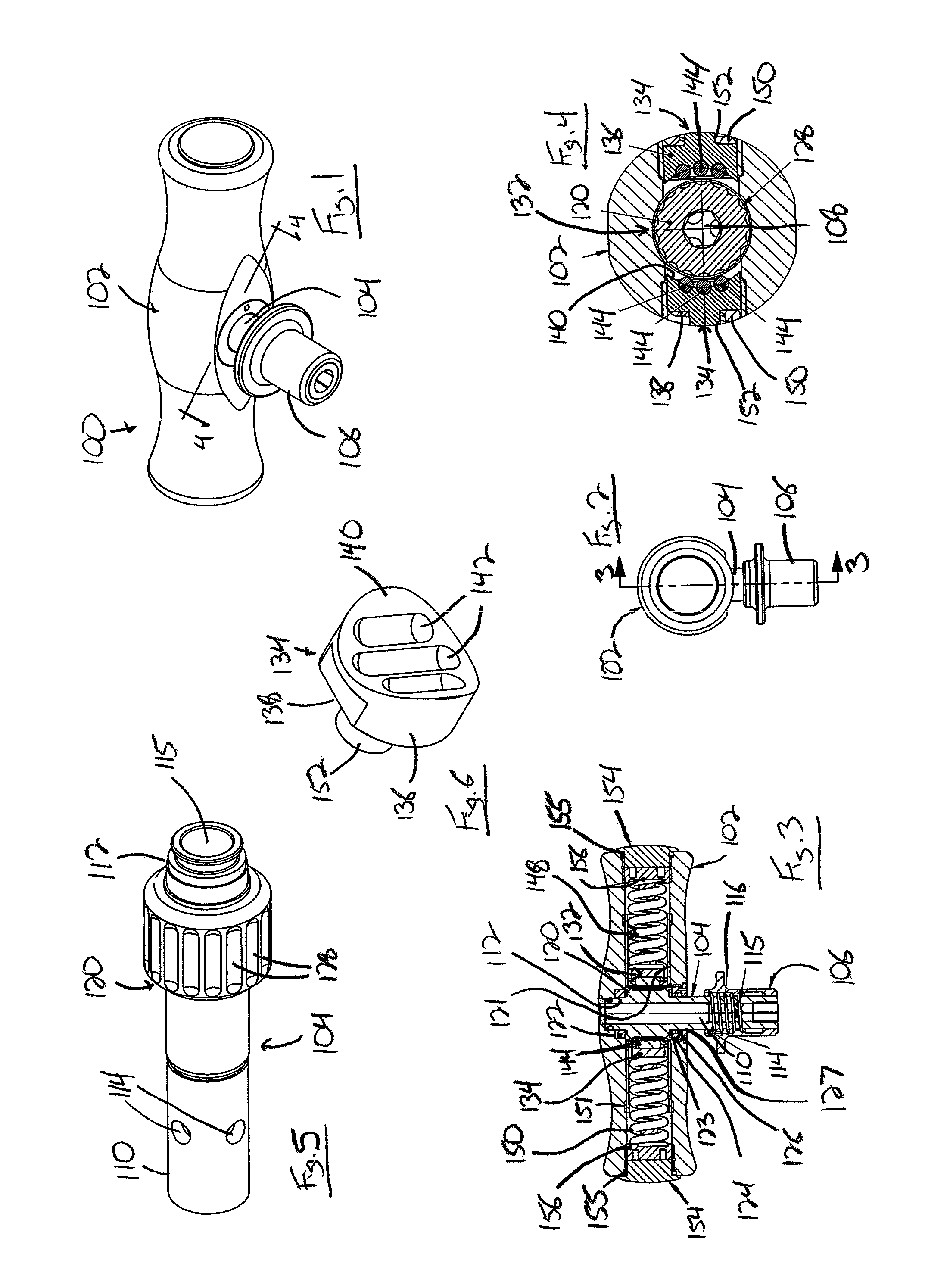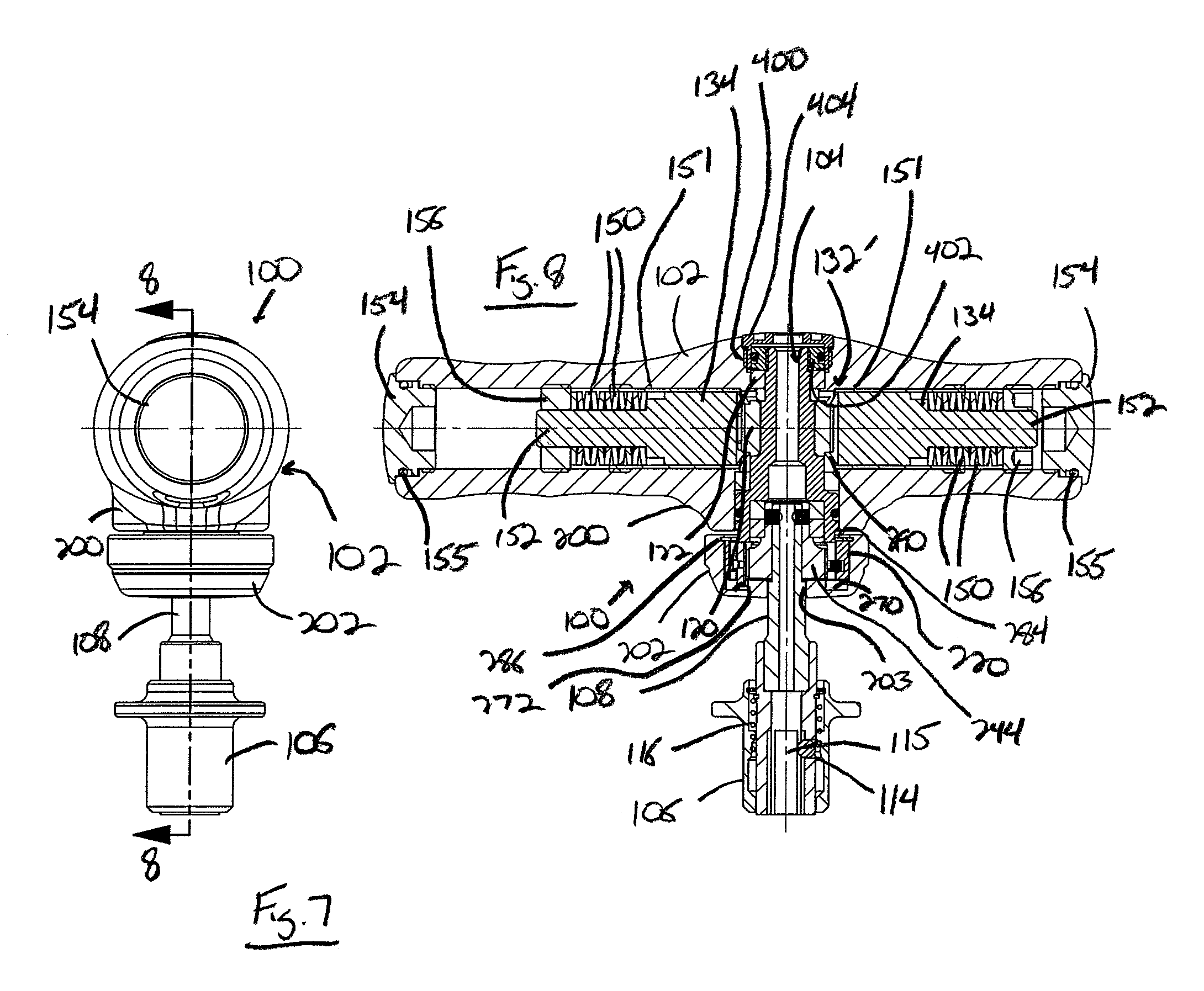Ratcheting torque wrench
a torque wrench and torque technology, applied in the field of torque wrenches, can solve the problems of lengthen and achieve the effects of reducing friction and resulting wear, reducing the profile, and prolonging the useful life of the tool
- Summary
- Abstract
- Description
- Claims
- Application Information
AI Technical Summary
Benefits of technology
Problems solved by technology
Method used
Image
Examples
first embodiment
[0031]With reference now to the drawing figures in which like reference numerals designate like parts throughout the disclosure, a torque wrench constructed according to the present invention is indicated generally at 100 in FIG. 1. The wrench 100 includes a handle 102 from which extends a shaft 104 having a drive shaft release member 106 attached thereto opposite the handle 102. Release member 106 is utilized to secure a drive shaft 108 thereto in order to drive a fastener (not shown) that is engaged by the fastener-engaging shaft 108 into a substrate.
[0032]Looking now at FIGS. 3-5, the drive shaft 104 includes an outer section 110 integrally connected to an inner section 112 that is positioned within the handle 102. The outer section 110 is generally cylindrical in shape and includes a number of circular openings 114 spaced equidistant around the outer section 110. The openings 114 are adapted to receive ball bearings (not shown) therein that are used to engage and retain the fast...
second embodiment
[0039]Referring now to FIGS. 7-9, the wrench 100 is illustrated. In this embodiment, the drive shaft 104 is offset from the center of the handle 102. Thus, the drive shaft 104 and fastener-engaging shaft 108 are positioned closer to one side of the handle 102, which allows the tool 100 to be utilized in locations where the previous embodiment of the tool 100 would be unworkable due to the length of the handle 102 extending from opposite sides of the drive shaft 104.
[0040]Further, as best shown in FIG. 8, due to the extended length of one side of the handle 102, the adjustment nut 156 is separated from the end cap 154 and disposed entirely within the channel 121 to vary the compression of the springs 150, thereby controlling the maximum torque level at which the mechanism 132 can be operated. In a preferred embodiment, the adjustment nut 156 is threadedly engaged with the interior of the channel 121 such that the nut 156 can be advanced or retracted within the channel 121 to the desi...
third embodiment
[0055]Referring now to FIG. 10, the torque limiting mechanism 300 for use within the tool 100 is illustrated. In the mechanism 300, the shaft 104 is integrally formed with a central section 302 having a generally square-cross sectional area adjacent the inner section 112 of the drive shaft 104. A frictional cam member 304 is formed with a generally square-cross section aperture 306 extending through the center thereof that is positionable around the central section 302 on the drive shaft 104 to secure the cam member 304 to the drive shaft 104. The cam member 304 has an exterior surface 308 with a number engaging surfaces 310 formed thereon that, in a preferred embodiment, is formed as a hexagonal surface 312. The hexagonal surface 312 forms a number of flat friction panels 314 spaced equidistant around the surface 312. The surfaces 314 on opposite sides of the cam member 304 are engaged by plungers 316 having generally flat engaging surfaces 318 that are pressed against the friction...
PUM
 Login to View More
Login to View More Abstract
Description
Claims
Application Information
 Login to View More
Login to View More - R&D
- Intellectual Property
- Life Sciences
- Materials
- Tech Scout
- Unparalleled Data Quality
- Higher Quality Content
- 60% Fewer Hallucinations
Browse by: Latest US Patents, China's latest patents, Technical Efficacy Thesaurus, Application Domain, Technology Topic, Popular Technical Reports.
© 2025 PatSnap. All rights reserved.Legal|Privacy policy|Modern Slavery Act Transparency Statement|Sitemap|About US| Contact US: help@patsnap.com



